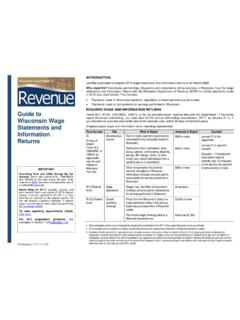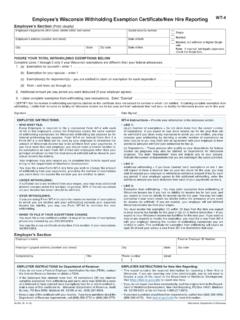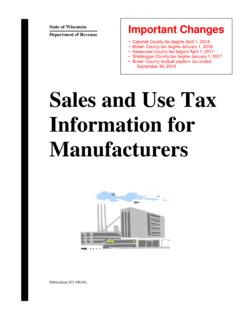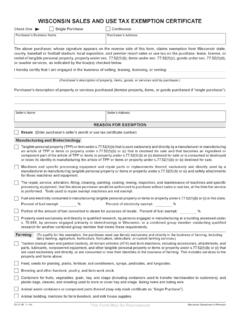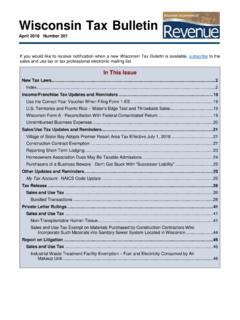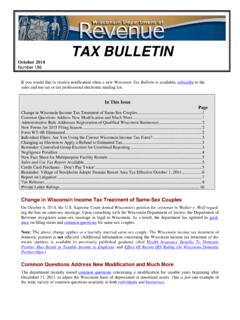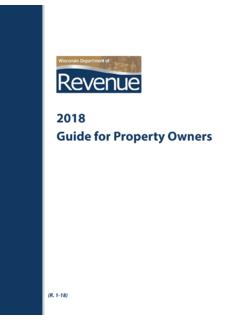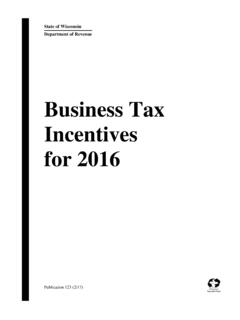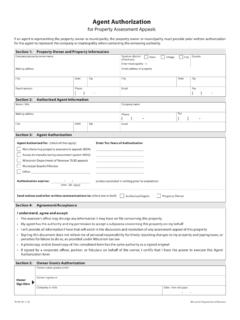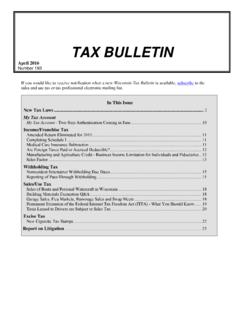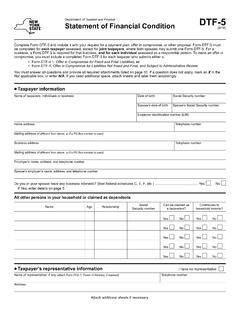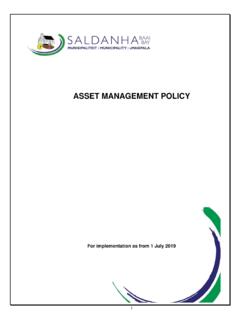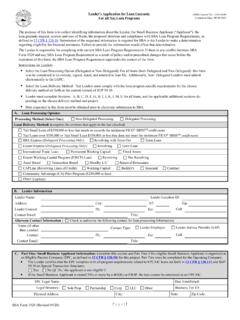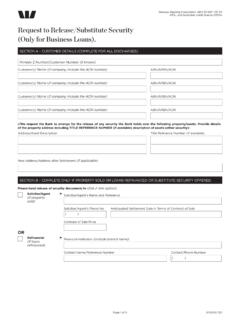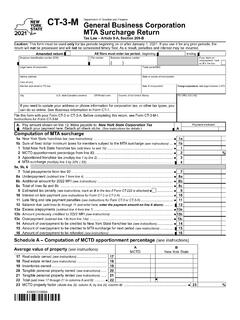Transcription of 2022 Guide to Wisconsin Manufacturing Property Assessment
1 2022. Guide to Wisconsin Manufacturing Property Assessment (R. 12-21). Guide to Wisconsin Manufacturing Property Assessment 2022. Table of Contents I. Introduction .. 3. II. Manufacturing Classification .. 3. A. SIC manual .. 3. B. Personal Property vs. real Property .. 3. C. Personal Property tax exemption.. 3. D. Requesting a Manufacturing classification .. 3. E. DOR issues a Manufacturing personal Property classification decision.. 4. F. DOR issues a Manufacturing real estate classification decision.. 4. G. Statutory filing requirements .. 5. III. Manufacturing Assessment Values.. 7. A. Market value for real estate .. 7. B. DOR site visits .. 7. C. Your real estate Assessment determination .. 7. D. Your personal Property Assessment determination .. 8. IV. Taxable Manufacturing Personal Property .. 8. A. Examples of taxable Manufacturing assets .. 8. B. Notice of Assessment .. 9. C. Assessment information is given to the municipal clerk .. 9. V.
2 Filing an Appeal .. 9. A. Before you file an appeal.. 9. B. Filing procedures .. 9. C. Filing the objection form .. 10. D. Submitting your appeal to DOR .. 10. VI. Board of Assessors .. 11. A. BOA's decision.. 11. B. Appealing the BOA determination .. 12. C. Municipal appeals .. 12. D. Withdrawing an appeal .. 12. VII. Resources/Contact Information .. 13. Back to table of contents 2. Guide to Wisconsin Manufacturing Property Assessment 2022. I. Introduction In 1973, the Wisconsin legislature created a state law (sec. , Wis. Stats.), making the Wisconsin Department of Revenue (DOR) responsible for the Assessment of Manufacturing real estate and personal Property . This law was created to help ensure fair and equitable assessments for Manufacturing Property and Assessment uniformity statewide. II. Manufacturing Classification A Manufacturing operating establishment is engaged in the assembling, processing, fabricating, making or milling of tangible personal Property for profit.
3 A. SIC manual The Standard Industrial Classification Manual (SIC Manual) organizes economic activities and defines industries for reporting economic statistical data. The manual organizes business establishments based on primary activity into nine divisions. Within Division D Manufacturing establishments engaged in the mechanical or transformation of materials or substances into new products are organized into 20 major groups of similar activity. The 1987 Edition plays a major role in identifying business activities that qualify as Manufacturing . Under state law (sec. (2), Wis. Stats.), an operating establishment may be classified as " Manufacturing " if the operating establishment's activity is included in one of the major group classifications found in Division D of the SIC Manual. B. Personal Property vs. real Property Manufacturing personal Property includes all personal Property owned or leased by the manufacturer (ex: machinery and equipment, furniture and fixtures, copiers and telephone systems, computers, supplies).
4 Manufacturing real estate includes land and buildings substantially used in support of the Manufacturing operation C. Personal Property tax exemption Machinery and special processing equipment the state budget bill, 2017 Wisconsin Act 59, created sec. (27), Wis. Stats., which exempts from Property taxes machinery, tools and patterns reported on Schedule C. of the Statement of Personal Property (PA-003). The exemption only applies to Property that was or would be reported on Schedule C - Machinery, Tools and Patterns, per sec. , Stats. The Property is exempt starting with January 1, 2018 assessments. The exemption does not apply to Manufacturing Property . D. Requesting a Manufacturing classification To obtain the machinery and equipment Property tax exemption under sec. (27), Wis. Stats., your business activity must be classified as Manufacturing by DOR's Manufacturing & Utility Bureau. 1. Qualifying as a manufacturer If you feel your business activity qualifies as Manufacturing , you must contact the Manufacturing & Utility Bureau District Office in your area in writing, by March 1 of the Assessment year.
5 Requests received after March 1 are considered for the following year. Complete the Questionnaire for Potential Manufacturers ( form PA-780) and submit it to the Manufacturing &. Utility Bureau District Office where your Property is located Back to table of contents 3. Guide to Wisconsin Manufacturing Property Assessment 2022. Include a fixed asset list or depreciation schedule detailing all personal Property assets owned and/or leased by the business. For each asset, include an item description, original cost, and a date of acquisition. The business activity will not be considered for classification unless a fixed asset list is submitted Note: DOR requests you write a letter or email, and provide a brochure or web address that helps explain your business activities. A visit to your Property may be required prior to classification. 2. Sales tax exemption Sales and use tax exemption may apply to machinery and equipment used by a business in producing tangible personal Property .
6 However, equipment qualifying for sales and use tax exemption, does not automatically qualify for a Property tax exemption. Note: Sales tax and Manufacturing Property tax are administered under different statutes. To be classified as Manufacturing with DOR's Manufacturing & Utility Bureau, you must complete the process described in Qualifying as a manufacturer. 3. Income tax credit The Manufacturing and agriculture credit is available to businesses engaged in a qualifying Manufacturing or agricultural activity. A claimant that is approved by the Wisconsin Department of Revenue to be classified as a manufacturer for purposes of sec. , Wis. Stats., but who is not eligible to be listed on the department's Manufacturing roll until January 1 of the following year, may claim the credit in the year in which the Manufacturing classification is approved. If you have questions, contact Corporation Franchise/Income Tax Assistance at (608) 266-2772 or E. DOR issues a Manufacturing personal Property classification decision 1.
7 Manufacturing classification is granted If your business activity meets the requirements for a Manufacturing classification, DOR sends you written confirmation that DOR classified your business as a Manufacturing activity 2. Manufacturing classification is denied If your business is denied Manufacturing classification, DOR sends you a letter explaining the basis for the denial DOR also sends a copy of the denial letter to the municipal assessor to avoid an omitted Assessment . This letter states that the local assessor is responsible for your Property Assessment . If you have questions: Contact the Manufacturing & Utility Bureau District Office in your area to discuss the basis for the decision. If you remain dissatisfied, you can file an appeal with the Wisconsin State Board of Assessors (BOA), objecting to the classification denial. For more information, review Filing an appeal in this Guide . F. DOR issues a Manufacturing real estate classification decision 1.
8 Substantial use State law (sec. (4), Wis. Stats.), states in part, "..For all purposes of this section the department of revenue shall have sole discretion for the determination of what is substantial use and what description of real Property or what unit of tangible personal Property shall constitute ''the Property " to be included for Assessment purposes, and, in connection herewith, the department may include in a real Property unit, real Property owned by different ". The substantial use of real estate by a manufacturer generally determines whether the Assessment responsibility is with DOR or the municipal assessor. Back to table of contents 4. Guide to Wisconsin Manufacturing Property Assessment 2022. DOR generally assesses the real estate if a classified manufacturer occupies more than 50% of the square footage in the building Municipal assessor generally assesses the real estate if a classified manufacturer occupies less than 50%. of the square footage in the building.
9 Occupancy can be based on a lease agreement, or the area used Note: If the substantial use of the real estate changes, DOR investigates the change. Assessment authority will shift from DOR to the municipal assessor if a non- Manufacturing use is imminent. If you have questions: Contact the Manufacturing & Utility Bureau District Office in your area to discuss the basis for the decision If you remain dissatisfied, you may file an appeal with the Wisconsin State Board of Assessors (BOA), objecting to the classification denial. For more information, review Filing an appeal in this Guide . G. Statutory filing requirements 1. Personal Property if you own or lease personal Property as a classified manufacturer M-P form you must annually file a Manufacturing Personal Property Return (PA-750P). You must file a separate M-P form for each account located in a different taxation district or special district (Examples of special districts include: tax incremental districts (TIDs), school districts, technical colleges, and sanitary districts).
10 Examples of personal Property reported on the M-P form : boats and watercraft, machinery tools and patterns, boilers, copiers and telephone equipment, furniture, fixtures and equipment, leased items, leasehold improvements, supplies, and buildings on leased land 2. Real estate if you own or lease real estate classified as Manufacturing M-R form you must annually file a Manufacturing Real Estate Return (PA-750R). You must file a separate M-R form for: Each parcel or legal description - parcels must not be combined on one M-R form Property located in different special districts within the same municipality are considered separate parcels Real estate changes to report on the M-R form include: new construction, construction in progress, remodeling, demolition, land improvements, waste treatment, and lease information Note: Both M-Forms collect changes in personal Property assets or changes made to your real estate from January 1. of the prior year, to January 1 of the current year Your Assessment is based on what is in place as of January 1.
